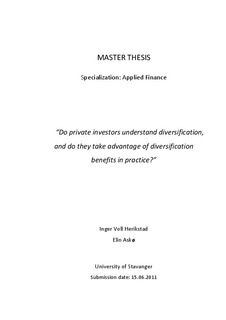| dc.contributor.author | Herikstad, Inger Voll | |
| dc.contributor.author | Askø, Elin | |
| dc.date.accessioned | 2011-09-05T17:31:47Z | |
| dc.date.available | 2011-09-05T17:31:47Z | |
| dc.date.issued | 2011 | |
| dc.identifier.uri | http://hdl.handle.net/11250/183859 | |
| dc.description | Master's thesis in Finance | en_US |
| dc.description.abstract | We found our Master thesis to be the optimal opportunity to examine the important phenomenon of diversification, but from a different angle than what earlier researchers have done. Diversification is a useful technique for reducing risk in a portfolio and several researches over the years have agreed on the importance of diversification. We observed that researchers tended to base their research on different stock exchanges or brokerage accounts, and put little emphasis on the motives behind private investors´ financial behavior. Our thesis differs from earlier research due to its focus on the theoretical and practical understanding that private investors possess. Based on the fact that several private investors seem to under-diversify, we wanted to investigate the reasons and eventual explanatory variables. After thorough research we decided on the following research question:
“Do private investors understand diversification, and do they take
advantage of diversification benefits in practice?”
To best answer our research question we used both qualitative and quantitative methods. We chose to conduct an experiment, where the candidates consisted of undergraduate students studying Business Administration at the University of Stavanger. The experiment was divided into two parts. In part one we tested how the students behaved in a practical setting. We asked the students to make their individual investment decisions based on five stocks. We wanted to examine if they discovered and took advantage of the fact that two of the stocks had a high negative correlation, and thus gave the optimal diversification benefit. We divided the class into two treatment groups, where one group received an easy version, and the other group a more advanced. This made it possible for us to discover the students’ degree of understanding. In part two we aimed at determining their risk preferences and theoretical knowledge about diversification. We had the students perform three different exercises, which were identical for the two treatment groups.
The main findings were that the students in both treatment groups seemed to have relatively high theoretical knowledge about diversification. However, in practice none of the treatment groups did seem to act according to their theoretical understanding. We found that both groups diversified to some degree by spreading their investments in several or all of the five stocks, but did not discover the correlation effect that lead to the highest diversification benefit. We found that less than 1/3 of the students invested in the two stocks that gave the highest risk reduction.
Our conclusion is that the private investors we studied understand diversification in theory, but they do not apply this knowledge in practice. We believe that this specific research area deserves further examination, especially when it comes to emphasize on the importance of linking psychological aspects with financial theory. | en_US |
| dc.language.iso | eng | en_US |
| dc.publisher | University of Stavanger, Norway | en_US |
| dc.relation.ispartofseries | Masteroppgave/UIS-SV-HH/2011; | |
| dc.subject | økonomi | en_US |
| dc.subject | anvendt finans | en_US |
| dc.subject | diversification | en_US |
| dc.subject | administrasjon | en_US |
| dc.title | Do private investors understand diversification, and do they take advantage of diversification benefits in practice? | en_US |
| dc.type | Master thesis | en_US |
| dc.subject.nsi | VDP::Social science: 200::Economics: 210 | en_US |
